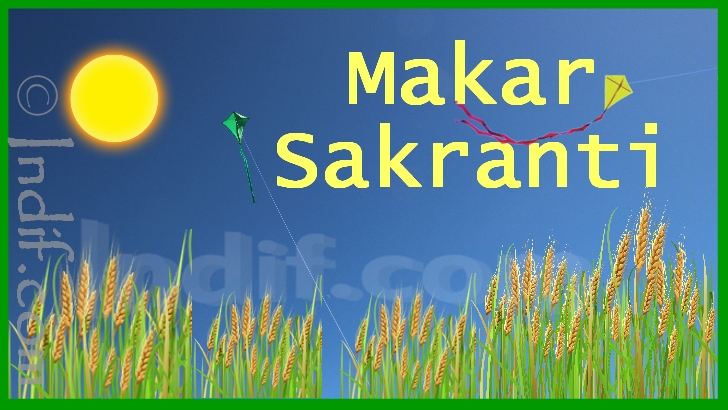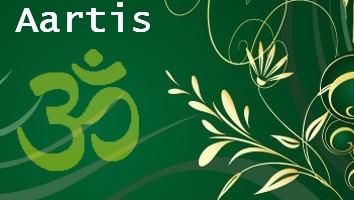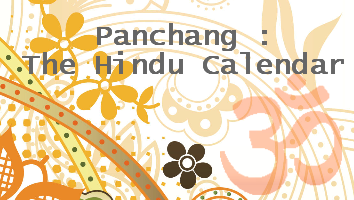Makar Sankranti is an important festival in India. It is celebrated in the month of 'Magh' according to the Hindu calendar and usually occurs in the month of January. It is associated with the sun, it is one of the few Indian festivals which falls on the same day every year in the Western Calendar - January 14th (or 15th if it's a leap year). Hindu festival calendar is based on lunar months and it changes every year according to the phases of the moon. So all the dates for the Indian festivals changes every year except Makar Sankranti because it is the only Indian festival that is celebrated according to the solar calendar.
‘Makar’ means 'Capricorn'. 'Sankranti' means ‘movement or change.’ Makar Sankranti takes its name from the movement of the Sun into Makara or Capricorn and is celebrated as the start of the harvest season and the end of the northeast monsoon in South India. The Makar Sankranti festival is also known and referred to as the harvest festival because this is the time when harvesting is complete and there are big celebrations. This is the day we acknowledge all those who assisted in making the harvest.
Celebrations:
Just like Lohri, Makar Sankranti is celebrated throughout India as a harvest festival. It is a way of giving thanks to the elements of nature for their precious crops. Lord Surya (Sun God) is worshiped on this day. It is celebrated with great devotion, fervor and gaiety as the harvest festival of the state at many places in the Indian subcontinent.
On Makar Sankranti, the Gayatri mantra is chanted and prayers are performed. Also on this day millions of people bathe in river Ganga. On the day of Makar Sankranti, fairs are held at Ganga Sagar, Kumbh Mela in Allahabad and millions of people take a dip in the holy waters of Ganga. Simple food is the order of the day and many people prepare ‘kichari’ on this day. Sweets and dishes made out of Sesame oil (Til) are served on this day. Sweets made out of Til is exchanged as mark of friendship. The symbolic meaning is to emulate the quality of Tilgul – to stick together even in adversity.
Makar Sankranti is celebrated with different names throughout India, by observing different rituals -
Tamil Nadu - Makar Sankranti is celebrated as Pongal - a harvest festival. It is the Tamil equivalent of Thanksgiving. In Tamil-Nadu it is a four-day festival of thanksgiving to nature takes its name from the Tamil word meaning "to boil".
Gujarat - In the state of Gujarat, it is observed as Uttarayan. Gujarat celebrates 2,000 festivals every year! Among these, the festival of Uttarayan is one of the grandest. This day is celebrated as the famous Kite festival in Gujarat. On this beautiful day, millions of people fly colorful and vibrant kites on their roof tops. The sky is filled with a rainbow of kites.
West Bengal - In West Bengal, it is known as Pithey parban – a harvest festival, and there is also the famous Ganga Sagar mela.
Assam - In the state of Assam, Makar Sankranti is known as Bhogali Bihu. ‘Bhogali’ means ‘feasting’ in Assamese and is a two-day festival, dedicated to Agni, the fire god.
North-Eastern States - In the states od Punjab, Jammu and in some parts of Himachal Pradesh and Haryana, it is celebrated a day before as the festival of Lohri.
Uttar Pradesh - In Uttar Pradesh Makar Sankranti is celebrated with religious fervor. As per the traditions, they take a ritual bath in the holy River Ganga. Thereafter, they would worship their favorite good, seeking a good harvest year after year. Donating Khichdi (a cooked mixture of rice and lentils) on Makar Sankranti is considered auspicious, and is a popular tradition. A big fair is organized at Triveni Sangam in Allahabad, as a part of the celebrations of Makar Sankranti. This fair is known as Magha Mela.
Andhra Pradesh - In Andhra Pradesh, it is known by the name Sankranthi "Pedda Panduga" - a harvest festival. It is celebrated for four days.
Legends and Myths :
Like every festival of India, there are few legends and myths associated with the festival of Makar Sankaranti -
- According to one of the myths, it is related to the death of Bhishma Pitamaha in the Mahabharata. As per Hindu mythology in the Kaurav and Pandav battle od Mahabarata, Bhishma Pitamah’s body was pierced all over by several arrows and he fell from his chariot but his body did not touch the earth rather rested on a bed of arrows which stuck out of his body. He couldn’t die at this time because by this time the sun had already crossed the equator to the southern hemisphere (Dakshinayan had started). Bhishma pitamah had a boon that he could choose the time of his death so he had to wait 6 long months on the bed of arrows for an auspicious moment of death and that would be when the sun returns to the northern hemisphere (Uttarayan). So he chose Makar Sankranti, to go for his heavenly abode. It is believed that people who die during Uttarayana merges with the Brahman, thus ending the cycle of rebirth.
- Another legend is that King Bhageeratha brought Ganga down to earth on Makar Sankranti day. King Bhagiratha performed prayers to Brahma for 1000 years, wanting to purify the souls of his ancestors but only river Ganga could do that by washing their ashes. For that Ganga had to be brought to earth from the heavens. Brahma appeared and offers to send Ganga to earth but warns that her immense force of entry would destory earth. Brahma thus asks Bhagiratha to appease Shivji for this challenging task. Bhagiratha prays to Shivji and finally Shivji agrees to break the force of Ganga’s entry in his matted hair. The legend says that on the auspicious day of Makar Sakranti, the thundering Ganga descended from himalayas and crashed on the head of Shivji who in return seizes all her energy through his matted hair, so that she can flow on earth and purify every soul.
Significance of Til (Sesame Seed) and Gur (Jaggery):
Til and gur are an essential part of this festival. On this festival, people exchange sweets made of Til and Gur like til ladoos or tilguls . Since the seeds of til have a superior capability to attract and emanate Sattva frequencies, eating or distributing tilgul improves spiritual knowledge. When we share sweets made of sesame seeds, we share the Sattvic elements. The essential concept in the exchange of sweets is to disregard the precedent ill-feelings and conflict and decide to create a friendly atmosphere around.
Seekers of Truth, aspirants on the path of Yoga, devotees of God, lovers of mankind, all these have to pay tribute to the supreme father of energy, vital, which is Surya. ‘Suryah pratyaksha devata’ (The Sun is the visible God). If you have any visible God, it is the Sun before you. You cannot see God in His pristine excellence, but you can see God through the operation of his powers in nature. So, this particular day, we call Makara Sankranti, is holy.
- Swami KrishnanandaThe sun signifies knowledge, spiritual light and wisdom. Makar Sankranti signifies that we should turn away from the darkness of delusion in which we live, and begin to joyously let the light within us shine brighter and brighter. We should gradually begin to grow in purity, wisdom, and knowledge, even as the sun does from this day.
- Swami Sivananda


 Collection of Hindu Vrat and Upavas Kathas
Collection of Hindu Vrat and Upavas Kathas






